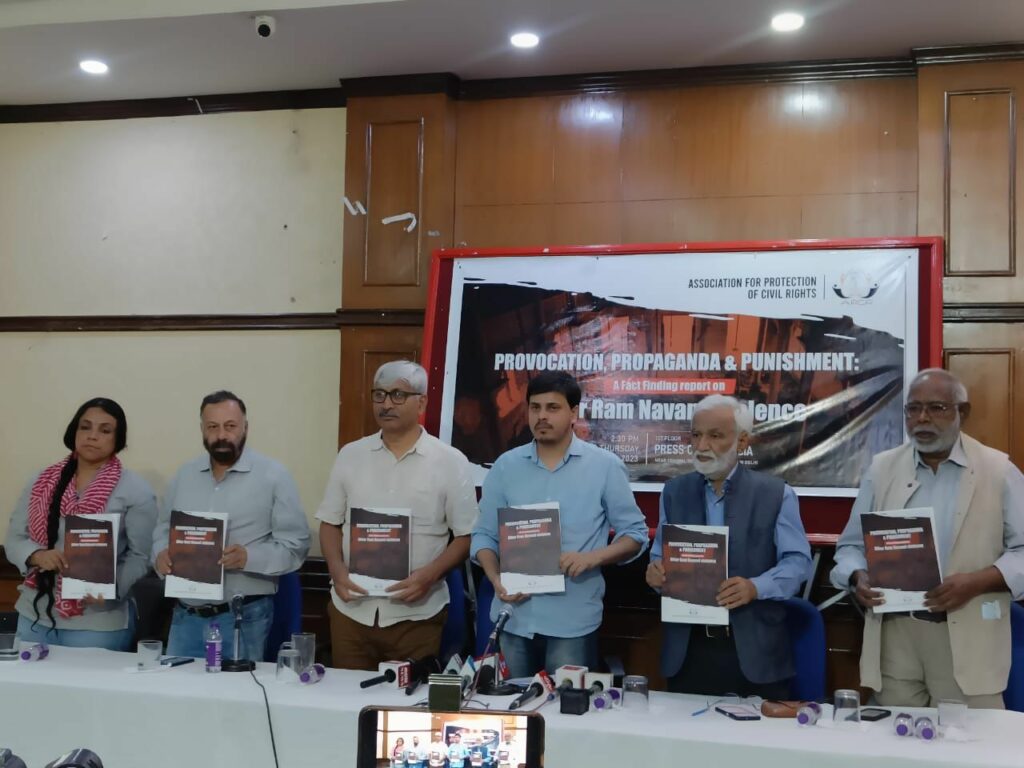In order to investigate what led to the violence during Ram Navami processions in Bihar and to analyse the situation on the ground, Association for Protection of Civil Rights (APCR) Fact-Finding Team visited Bihar Sharif and Sasaram and recorded the testimonies of families who sustained injuries and suffered financial loss. The fact-finding report reveals a complete failure of the state and how Bajrang Dal members hoisted their flags in the presence of the police, who did nothing to stop them.
“On April 30, 2023, the Shobha Yatra procession passed without escalating into severe violence. However, on April 31, 2023, the situation turned grotesque as the crowd brandished swords and played vulgar communal songs, provoking the Muslim community during Friday prayers. The violence intensified when the crowd set fire to the over 100-year-old MadrasaAzizia, destroying 4,500 books. Local shops and vendors also suffered significant property losses. In Bihar Sharif alone, it is estimated that 60,000 people participated in Shobha yatra and eyewitnesses have also alleged that CCTV cameras were removed a few days back of violence near Gagan Diwan Petrol Pump, the report said.
The report puts forth several recommendations, urging the state government to compensate the victims of violence who have lost their livelihood and shelter and were severely attacked by Bajrang Dal goons.
Prashant Tandon, a veteran journalist, observed that the recent violence during Ram Navami in Bihar, specifically in Bihar Sharif and Sasaram, was pre-planned and concurrent. They mentioned that in 2018, similar violence had occurred, but it was controlled by following directives from the peace committee, such as avoiding provocative songs and weapons, which were approved by the administration.
MobashshirAneeq, Advocate, referred to a 2018 report with recommendations, but noted that in 2023, there was a lack of on-ground implementation of the peace committee’s directives. He highlighted that the violence caused significant damage, and questioned the silence of local politicians and the biased actions of the police.
Bhasha Singh, a journalist, emphasised the importance of fact-finding to counter fake news and highlighted the planned nature of the violence, expressing concern over the lack of accountability of those responsible, including politicians. She also mentioned the use of festivals for political gain and the potential radicalisation of unemployed youth.
John Dayal, a renowned social activist, highlighted the issue of Islamophobia, stating that it is a ticking time bomb that is destroying the country. He mentioned instances of schools and communities promoting Islamophobia, and the need for secularism and political action to counter the violence. He also stressed the importance of fact-finding and detoxifying the community from hatred.
Professor Apoorvanand observed: Ram Navami processions in Bihar have been used as a weapon to incite violence against Muslims, with reports showing a pattern of destruction of Muslim homes and businesses. Police must be held accountable and the Hindu community should take initiative to prevent their children from participating in such violence.
Urmilesh, a senior journalist, said: Bihar is not an exception when it comes to violence during festivals, particularly Ram Navami processions. Lack of efforts by the administration and political polarisation contribute to the problem. Weapons are used.Better political party efforts are needed to control such violence.
Sanjay Hedge, a Senior Advocate of the Supreme Court, said: Private reports may not have immediate impact, but they contribute to long-term change. The struggle against memory and the powerful who do not want us to remember is ongoing. Change is needed not only in Bihar but across the country to achieve hope and liberty.
The fact-finding team comprised Mohammad MobashshirAneeq Advocate, Prashant Tandon Sr. Journalist, Saiful Islam Advocate, Gulrez Anjum Social Activist, Nasiquz Zaman Advocate, Mohammad Zahid Social Activist, and Akbar.


